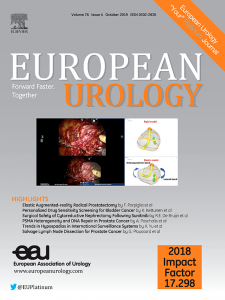Epidemiology and Risk Factors for Testicular Cancer: A Systematic Review
IF 25.2
1区 医学
Q1 UROLOGY & NEPHROLOGY
引用次数: 0
Abstract
Background and objective
Testicular germ cell tumors (TGCTs) are globally rare, although incidence significantly varies across global geographic regions and ethnicities. Recent decades have seen an unexplained increase in incidence. This review investigates the changing epidemiology of TGCT and identifies key risk factors.
Methods
A systematic review following the Preferred Reporting Items for Systematic Reviews and Meta-analyses 2020 statement was conducted. After screening and risk-of-bias assessment, 53 reports on significant and updated topics on TGCT epidemiology and risk factors were included for narrative synthesis. Of these, 26 were selected for quantitative synthesis.
Key findings and limitations
Projections suggest a continued increase in global TGCT incidence, even in populations with historically low incidence. Genetic predisposition, particularly single-nucleotide polymorphisms, accounts for approximately 44% of TGCT heritability. In utero exposure to endocrine-disrupting chemicals, cryptorchidism, infertility, high height, behavioral factors such as marijuana consumption, and environmental or occupational exposures to potentially harmful substances are associated with higher TGCT risk, with variable strength of evidence. Meta-analyses confirmed a significant association between prenatal/early-life risk factors and TGCT incidence (odds ratio 1.44). Limitations include constrained evidence quality, heterogeneity in study types, and a limited volume of data supporting each topic.
Conclusions and clinical implications
TGCT pathogenesis is influenced by genetic predisposition and exposures during early life. The rising incidence may reflect socioeconomic changes and migration patterns, which determine variation in population exposure to risk factors. TGCT epidemiology remains controversial and requires further research and the implementation of optimal screening programs considering the rising incidence and consequent impact on global health and socioeconomic systems.
睾丸癌的流行病学和风险因素:系统回顾
背景和目的睾丸生殖细胞瘤(TGCTs)在全球范围内都很罕见,但不同地理区域和种族的发病率差异很大。近几十年来,发病率出现了不明原因的增长。本综述调查了TGCT不断变化的流行病学,并确定了关键的风险因素。方法按照《2020年系统综述和荟萃分析首选报告项目》声明进行了系统综述。经过筛选和偏倚风险评估后,纳入了 53 篇有关 TGCT 流行病学和风险因素的重要和最新主题的报告进行叙述性综合。主要发现和局限性预测表明,即使在历史上发病率较低的人群中,全球 TGCT 的发病率也会持续上升。遗传易感性,尤其是单核苷酸多态性,约占 TGCT 遗传性的 44%。子宫内暴露于干扰内分泌的化学物质、隐睾症、不育症、身高过高、行为因素(如吸食大麻)以及环境或职业中暴露于潜在有害物质与较高的 TGCT 风险有关,但证据的强度各不相同。元分析证实,产前/早孕期风险因素与TGCT发病率之间存在显著关联(几率比1.44)。结论和临床意义TGCT的发病机制受遗传易感性和生命早期暴露的影响。发病率的上升可能反映了社会经济的变化和移民模式,这决定了人群暴露于风险因素的差异。TGCT流行病学仍存在争议,考虑到发病率的上升及其对全球健康和社会经济体系的影响,需要进一步研究并实施最佳筛查计划。.患者总结。
本文章由计算机程序翻译,如有差异,请以英文原文为准。
求助全文
约1分钟内获得全文
求助全文
来源期刊

European urology
医学-泌尿学与肾脏学
CiteScore
43.00
自引率
2.60%
发文量
1753
审稿时长
23 days
期刊介绍:
European Urology is a peer-reviewed journal that publishes original articles and reviews on a broad spectrum of urological issues. Covering topics such as oncology, impotence, infertility, pediatrics, lithiasis and endourology, the journal also highlights recent advances in techniques, instrumentation, surgery, and pediatric urology. This comprehensive approach provides readers with an in-depth guide to international developments in urology.
 求助内容:
求助内容: 应助结果提醒方式:
应助结果提醒方式:


